Pedro Funes has his Viols of the Creek students share the responsibility, both social and musical
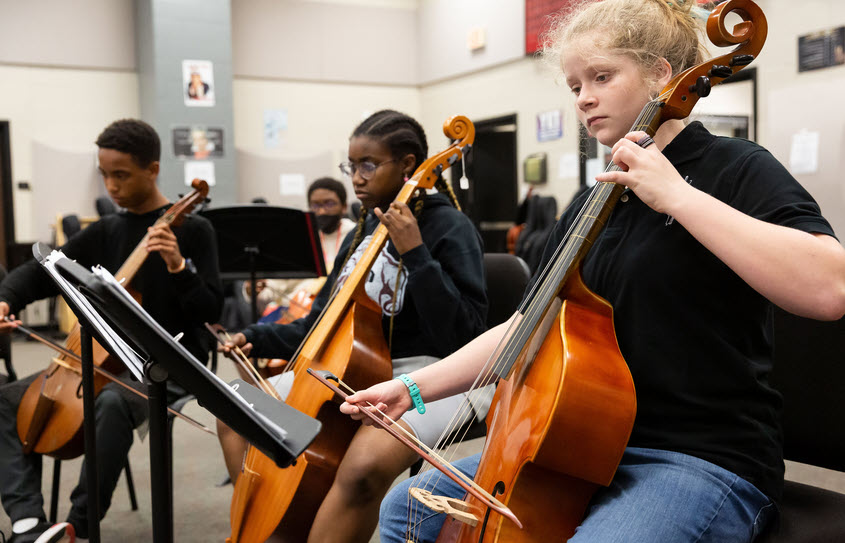
“Hey Mom, can you drive me to consort practice?” is a question uttered only in a handful of places in the U.S.
Humble, Texas is one of them.
Walk down the halls of Woodcreek Middle School on a Thursday morning or Friday afternoon, and you’d behold an unexpected sight: a group of kids playing treble, tenor, and bass viols in consort. Seated among them, bowing a treble viol, is their teacher, Pedro Funes.
Funes teaches orchestra at Woodcreek Middle School, just outside of Houston, where he also leads Viols of the Creek, an extracurricular viola da gamba consort. (Before that, he’d introduced a similar program at Oak Ridge High School in Conroe, north of Houston.)
The Viols of the Creek consort meets in two sections, one for beginners and the other for more advanced players. At present, each group has about a dozen students, who must also play violin, viola, cello, or bass in their middle school or high school orchestra program. This year, viol students range from the eighth to eleventh grades.
Each section meets an hour a week and plays a range of repertoire. Funes has found that students are quite open to playing traditional Renaissance consort music. “Honestly, if they don’t like something, they’ll just tell me,” he says with a laugh.
Many students, such as Vanessa Ponce (Oak Ridge High, Class of 2019), develop a strong appreciation for the repertoire. “I was excited to join, and I knew I’d get to learn new music, but being able to learn the history of the viol was great. Learning a whole different era of music and how to improvise with the viol was so fun!” she says. At the same time, the program proves that the viola da gamba can be applied to genres beyond its historical roots and has a place in the broader 21st-century musical landscape. The consort has played everything from folk-tune arrangements to the Beatles.
‘The nature of a consort ensemble, where all players are responsible for a line that enjoys equal weight in the musical texture, is particularly suited to these goals.’
Funes’ ultimate goal is for consort students to blossom into independent thinkers and musicians. The nature of a consort ensemble, where all players are responsible for a line that enjoys equal weight in the musical texture, is particularly suited to these goals. School administrators have taken note. Jenni Olges, Assistant Fine Arts Director for Humble Independent School District, applauds the program for providing an “opportunity for students to develop collaboration and problem-solving skills as they learn to create music on instruments” that are entirely new and unfamiliar. The Humble Independent School District serves an ethnically, racially, and socioeconomically diverse group of students. In numbers, 37 percent of the district is Hispanic, 34 percent is white, and 22 percent is Black. Forty percent qualify as “economically disadvantaged.”
To achieve the independent-thinker goals, Funes prepares his students to assume increasing levels of musical responsibility as they progress—a lot of handholding at the beginning, but also a high bar from the start. He intentionally never conducts, even in those first classes, charging students to keep their ensemble together. “This is student-led,” he explains. “I’m part of the ensemble. I always have a student start and lead a song.”
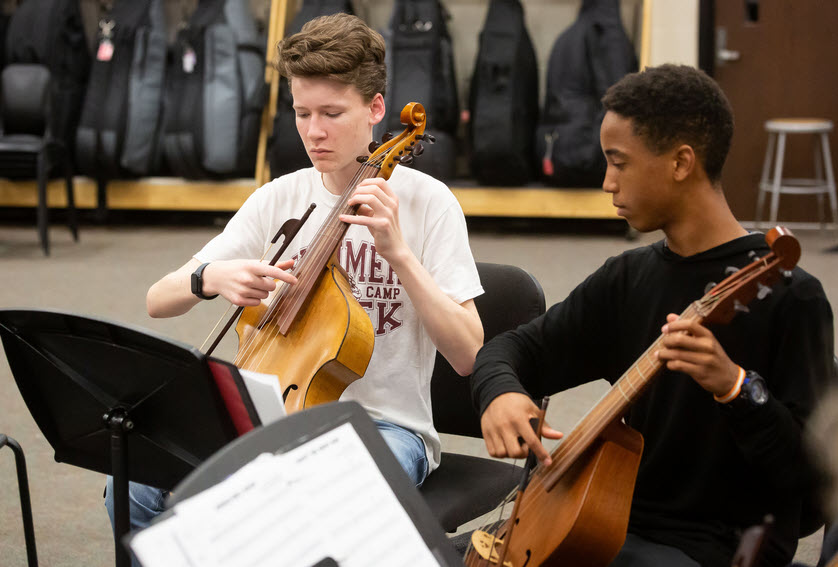 This level of autonomy is a very different experience for students who are used to playing in a section of 10 to 20 people in orchestra with a conductor at the helm. However, they consistently rise to the challenge. The most advanced among them eventually play polyphony one to a part—reading from parts! While there’s a learning curve, with great challenge comes the opportunity for deep satisfaction. Playing in consort “influenced me to become a stronger musician. I loved learning a new instrument that brought a unique meaning to an ensemble,” says Jonbeth Voltaire (Oak Ridge High, ’17).
This level of autonomy is a very different experience for students who are used to playing in a section of 10 to 20 people in orchestra with a conductor at the helm. However, they consistently rise to the challenge. The most advanced among them eventually play polyphony one to a part—reading from parts! While there’s a learning curve, with great challenge comes the opportunity for deep satisfaction. Playing in consort “influenced me to become a stronger musician. I loved learning a new instrument that brought a unique meaning to an ensemble,” says Jonbeth Voltaire (Oak Ridge High, ’17).
The opportunities are as social as they are musical. Although they may not realize it, students cultivate a group dynamic consistent with the viol’s history as a social instrument. On its webpage titled “Why Learn Viol?,” the Viola da Gamba Society of America (VdGSA) highlights the social nature of the centuries-old tradition of recreational consort playing: “In seventeenth-century England, many aristocratic men (and some women) learned the viol as part of their social education. Families and friends would gather to make music together; much of the great repertoire of English consort music was written for this kind of gathering.”
Community remains a cherished value among today’s consort players. “In historical performance we think a lot about the original meaning and social function of music that we play,” explains John Moran, president of the VdGSA. “Consort music was written by players for players, to be savored in intimate settings. It’s fundamentally different from 19th-century concert music. It is contrapuntal with truly equal parts, more enjoyable to an active participant than a passive listener.
“Even at the conservatory level,” Moran continues, “I want my viol consort class to be a refuge from the day’s other activities, a safe place where students can unwind after their other classes and rehearsals, and I think they really respond to that, taking away a deep love for the music.”
The “fundamentally different” history of the viol that Moran mentions is what contributes to the culture of music-making that many consort players enjoy today: “You will find viol players some of the friendliest, most welcoming people you will meet,” states the VdGSA.
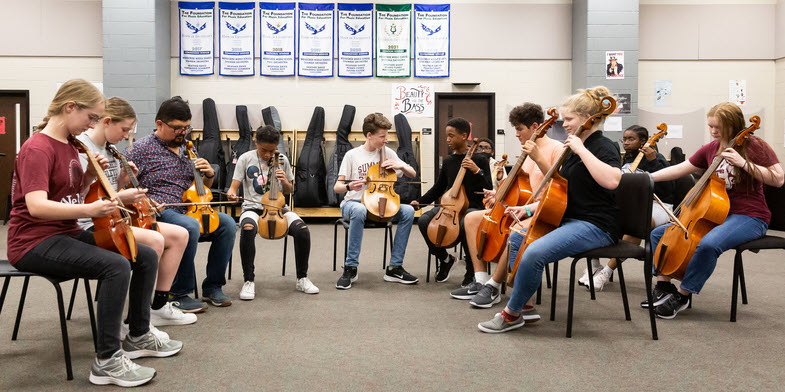
This collaborative culture plays out for Funes’ middle and high school students as well. “The relationships that [Viols of the Creek] develops with students are unmatched and foster an incredible sense of community and purpose,” notes Dr. Alan Moye, Principal of Woodcreek Middle School. Students who might compete with each other for a preferred seat in orchestra support each other in consort. Funes was delighted to see that this school year, his four tenor viol players decided to seat themselves so that the two more skilled players are optimally positioned to help the two players who need some extra support.
Funes sees this social dynamic as almost counter-cultural: “In Texas,” he says, “everything is a big competition. It’s all about winning awards and trophies. Orchestra is very competitive, but when it comes to gamba, the competition is gone. This is a different world.”
‘Orchestra is very competitive, but when it comes to gamba, the competition is gone. This is a different world.’
In this spirit, sweet treats appear at Viols of the Creek meeting. “What I love is that it’s a group of kids who really wouldn’t be friends any other way, because they’re all coming from different grades and levels of orchestra. I bring the cookies so they talk to each other and socialize when they wouldn’t otherwise,” Funes says. He also wants his students to experience the fun and relaxed environment that he has enjoyed at consort reading sessions: “I’m used to having coffee and donuts at reading sessions. I just feel like that’s proper etiquette for consort playing.”
Viol consort loan program
A Houston-area native, Funes first experienced consort reading sessions while he was an undergraduate at the University of Houston. As a junior majoring in double bass, he came to the realization that, contrary to what he thought as an incoming freshmen, he did not want to pursue a career as an orchestral musician. He started exploring other avenues. The director of the University Collegium Musicum connected him to a local viol teacher and to a group of eight or so viol players who met regularly for recreational consort reading sessions. Funes never looked back. He eventually went on to earn a master’s degree in historical performance from Indiana University.
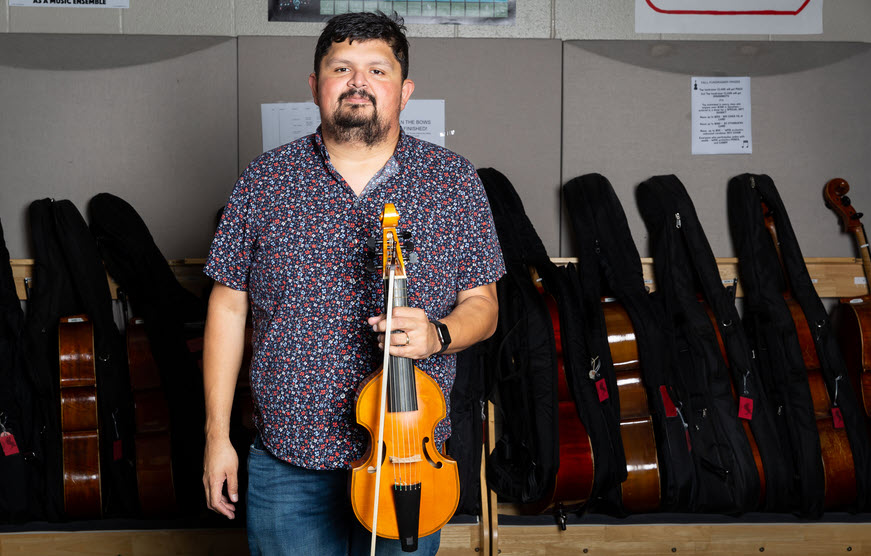
Yet he didn’t imagine running a school viol program when he began his career as a public-school orchestra teacher. During his first three years of teaching, in between his undergraduate and graduate studies, he made a point to bring his viol to class and to introduce the instrument to his orchestra students through hands-on demonstrations. The question “‘Where do I get one?’ always came up,” recalls Funes. At the time, his response was “I don’t know.”
When Funes returned to teaching after finishing his graduate studies, he finally had an answer: the VdGSA Consort Loan Program, designed to “empower teachers to begin viola da gamba programs, primarily for younger musicians, by providing instruments for a two-year period with the possibility of renewal.” With instruments on loan from the VdGSA, Funes started his first student consort at Oak Ridge High in Conroe. The consort, Aquila di Guerra (War Eagle), named for the school’s mascot, ran for four years and eventually became a for-credit class in the school’s music program. He’s kept in touch with many Oak Ridge students.
When Funes took a new job at Woodcreek Middle School, the viols went with him, as per the terms of the Consort Loan Program. Presently, the program is supporting consorts of four or more viols lent out to seven teachers, from Atlanta and Chicago to Kansas City, and Madison.
Over the years, Funes has acquired an increasing number of viols from the VdGSA program and from donors throughout Texas—typically people who own viols that they no longer play. Always on the lookout for more instruments, Funes says he posts regularly on social media to spread the word far and wide.
As the program grows, Funes is laying the groundwork for new communities of viol players to perpetuate and thrive. “I want to recreate what I had at Indiana University, opening the doors to having people to play with all the time. It’s all about meeting people, having a conversation, and playing gamba,” he says.
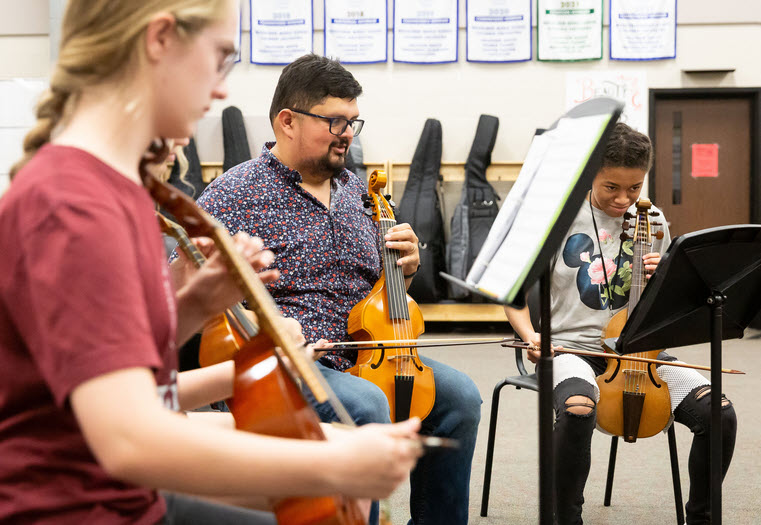
He’s already succeeding. Several former students have asked about how they can find an instrument to play and people to play with after high school. Some, such as Jack Meyer (Oak Ridge High, ’17) have branched out into communities of viol players from beyond Greater Houston. “I enjoyed my experience [in Aquila di Guerra] so much that I even ended up playing the bass viola da gamba in college. Joining Aquila di Guerra was one of the best decisions I’ve ever made and playing the viola da gamba is still a pivotal piece of my life to this day,” says Meyer. He has also twice attended the VdGSA Conclave, an annual week-long gathering of viol players of all levels from throughout the U.S., with a handful of international participants also in attendance. Others, like Matt Dunn (Oak Ridge High, ’20), are still active in the Houston area. Dunn currently plays tenor viol with Les Touches, an ensemble co-directed by Funes.
Part of getting students who already play modern instruments excited about playing viola da gamba is demonstrating that there is a place for young people in the community. “I try not to show pictures from centuries ago. Kids see pictures of guys wearing powdered wigs and weird clothes and can’t relate to it. Instead, I like to show pictures from the VdGSA website, so they see regular people playing gamba now,” says Funes. When he offers a viol demonstration to a new crop of middle schoolers, he brings along a younger colleague to play duets. Students can see, as he puts it, that “gamba can be for young people.”
Providing opportunities for students to engage with viol players throughout Texas is part of the plan. This school year, Houston Early Music provided free tickets for Viol of the Creek students to attend a performance featuring viol player Mary Springfels. In February, the students will travel to Austin to perform in the lobby before a concert of music by Orlando di Lasso, presented by the Texas Early Music Project.
Funes has managed to introduce students to early-music communities beyond Texas, having twice taken Aquila di Guerra to Boston to play on the VdGSA’s Gamba Gamut, a consort marathon that is presented as part of the Boston Early Music Festival’s Fringe Festival. These trips are a big hit with students. As Vanessa Ponce attests, “The biggest highlight of being a part of the Aquila di Guerra was the trips I was able to take because of the group. All the workshops both at school and outside of school and the trip to Boston were amazing! I learned so much and still enjoy the instrument even now.” In 2019, Funes was thrilled when BEMF offered students tickets to their centerpiece opera and exhibition, noting that “they loved trying out gut strings and so many instruments that they’d never seen before.” Funes hopes to bring Viols of the Creek to BEMF in future years, noting the challenges of student fundraising and district restrictions on the number of overnight trips a school group may take.
In the long term, Funes aspires to broaden his program to the district level, making the viol accessible to students at every district middle and high school. He feels encouraged by growing interest in the current viol program: “One of my dreams came true last year when we were invited to introduce the viol to educators who had no idea what it was at the Texas Music Educators Association convention. “It was like, the viol is back, everybody! It’s back! It is possible to make this happen!”
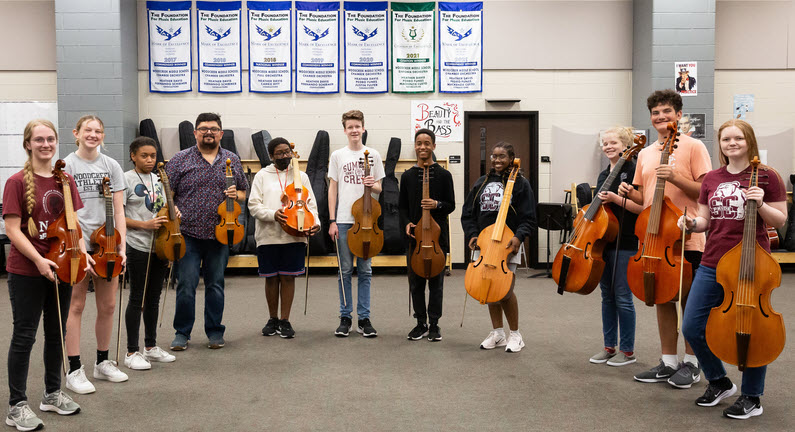
Though that level of expansion might be in the distant future, this year, Funes celebrates a big “game changer” that will make his tremendous efforts more sustainable. For the first time in eight years of running school programs, he will receive a stipend for running Viols of the Creek and funding for new strings and instrument repairs, which he’s been paying for out of pocket. The stipend and funding will be provided through the VdGSA’s GUTSY Grant, which supports “programs that foster interest and excellence in the gamba for younger people, especially those from historically marginalized communities.” Such a program in diverse Humble, Tx., makes an excellent fit for this grant.
John Moran explains that the GUTSY grant was enabled by a “generous one-time gift to the Society from a family foundation.” Other awardees include Patricia Ann Neely, who has launched a new viol program at LaGuardia High School in New York City, Shulamit Kleinerman for an initiative to expand viol teaching in her Seattle Historical Arts for Kids program, and Amy Domingues to start a new viol program at the University of Maryland, Baltimore County.
While Funes is very grateful to be a GUTSY grant recipient, he would not have been deterred in its absence: “I think my whole life’s purpose is to spread the gospel of the viol.”
Ashley Mulcahy is a Boston-based mezzo-soprano and graduate of the Voxtet Program at the Yale School of Music and Institute of Sacred Music. In addition to singing with numerous ensembles, she co-directs her own voice and viol ensemble, Lyracle.

